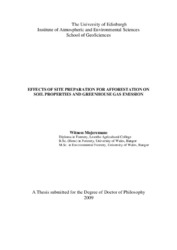| dc.description.abstract | Forest plantations in the UK are often established on seasonally waterlogged peaty gley soils which often require site preparation (drainage and mounding) to lower the water table and prepare planting positions. Substantial changes in the physical environment of peaty gley soils can accompany site preparation including fluctuations in soil temperature and soil moisture. These and other changes can all affect soil properties and decomposition processes and well as the dynamics of CO2, CH4 and N2O. A field experiment was established at Harwood Forest (NE England) to investigate the effects of three site management practices (drainage, mounding and fertilisation) frequently used for afforestation and replanting on peaty gley soils in the UK on soil properties and various of C and N, environmental variables (soil temperature, water content and water table height) and emissions of CO2, CH4 and N2O. The relationship between GHG emissions and environmental variables was also examined. The experiment was laid out in a factorial split-plot design. Drainage decreased C and N concentration in the 10 cm soil layer. The soil bulk density in the 0 to 20 cm soil layer was increased by mounding. Drainage and fertilisation increased soil CO2 efflux, whereas mounding did not affect soil CO2 efflux. All three practices affected soil CH4 fluxes with drainage reducing the fluxes and mounding and fertilisation increasing the fluxes. Nitrous oxide emissions were significantly affected by mounding and fertilisation, with mounding decreasing emissions and fertilisation increasing emissions. Soil temperature was the main environmental factor controlling soil respiration in this site. Over the two years study drainage and fertilisation increased the total greenhouse budget by 13.1% and 97.9%, while mounding caused a reduction of−17.6%. Drainage plus mounding reduced the total greenhouse budget by 6.9%, while drainage plus mounding plus fertilisation increased the total greenhouse budget by 101.8%. There is a potential for up-scaling GHG emissions from newly drained peaty gley for inclusion in the UK Land Use Land-Use Change and Forestry (LULUCF) Greenhouse Gas Inventory. However up-scaling and evaluation of the net emissions requires high quality data from different sites newly drained for afforestation. More studies are needed if net fluxes from newly drained sites are to the included in the LULUCF Greenhouse Gas Inventory. | en_US |

